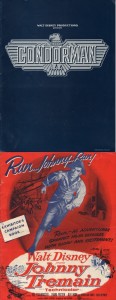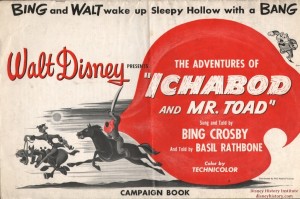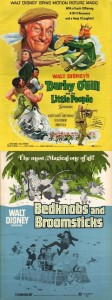About a year ago as we were going through the DHI Archives, Paul pointed out a few things that would be interesting to share with the DHI readers. One that stood out was the movie pressbooks, also known as Exhibitor Manuals. The booklets span from the 1930’s into the early 1980’s. I smiled, and sometimes grimaced, at some of the ideas Disney used to promote their movies like Peter Pan, The Shaggy Dog, Bedknobs and Broomsticks, Gala Night at Disneyland and even Condorman. Thus began my introduction into another form of Disney propaganda. (Something to note: the term propaganda as used today is held in a very different light than in previous decades. Think of how we use the term “promote.” That is the how the term propaganda was used back then, and how I am using it for this series.)
Pressbooks were created by the studios as a way to promote and market their movies and shorts. Inside you would find release information, interviews with the stars and their bios, advertisements that could be used in different media formats, pre-written reviews and articles, promotional ideas for contests and merchandise items.
With this new series, I want everyone to experience the anticipation of a movie build-up, as it used to be before the Internet, back when promotion was primarily accomplished with a trailer, radio spot or a newspaper article.
 For a couple reasons, I decided not to start from the beginning, with the early feature films. First and foremost, I would have to find the pressbook for Snow White and the Seven Dwarfs in the Archives. And second, in my real life, I will be boarding the Disney Dream in a few days. And who doesn’t think of sea monsters when on the ocean? But most importantly third, because of a recent event that took place in Walt Disney World.
For a couple reasons, I decided not to start from the beginning, with the early feature films. First and foremost, I would have to find the pressbook for Snow White and the Seven Dwarfs in the Archives. And second, in my real life, I will be boarding the Disney Dream in a few days. And who doesn’t think of sea monsters when on the ocean? But most importantly third, because of a recent event that took place in Walt Disney World. 


Looking forward to it! I love a lot of these old movies!!
I have the Press Book for Island at the Top of the World. As you describe, it contains photos and pre-written articles. About the only thing they didn’t seem to offer were electrotype plates so the newspapers could used the articles without having to copy or retypeset them. Perhaps they did and it is simply not obvious from the press book.
This whole side of the promotion business goes back to the beginning of the 20th Century when book publishers would supply magazines and newspapers with copies of books and a brief summary write-up. In many cases, these texts were used verbatim in a book’s press notice. These are not reviews, though some people looking at them today confuse them with a review. A review would have someone from the publication actually read the book and then summarize the book’s qualities or flaws. This takes work and leads me to my point on the Press Books.
It is still true today that people working in magazines and newspapers are busy and appreciate any opportunity which fills pages with a minimum of effort. Hence, press releases are sometimes pre-written articles that these publications might use. If you don’t supply the information in this easy-to-access form, you may not get your item published.
There were even issues where some television news programs included pre-recorded news programs in place of taking the information and doing their own reading. These did not go over well because the groups who supplied the video were seen as having an undue bias on their content and whatever the other side was leveled complaints about the use of such video. At the very least, the local talent should do their own reading even if they use supplied video.
Getting back to the Disney films, too many of these are unavailable, generally, on DVD. I did notice on Amazon last night many of the lesser-known films listed and that gives me some hope. I still lament the decision of the Disney Channel, some 10 years ago, to drop the Vault Disney programming block of late-night vintage programming that included older films and the television programs (Mickey Mouse Club, Zorro, Walt Disney Presents, etc.).